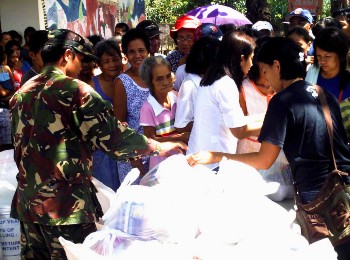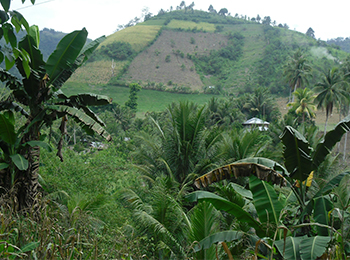About 1 result/s
-
Volume 5, Issue 1, August 2023
The Philippines is highly exposed and vulnerable to tropical cyclones (also known as typhoons), which caused over ₱352 billion worth of losses and damages to agriculture between 2000 and 2021. The study focuses on the impacts of typhoons on banana production in the Philippines. Bananas are a crucial crop for consumption, nutrition and the economy. Mindanao accounts for a majority of the country’s production. The study examines the physical sensitivity of bananas to hazards like typhoons, considering factors such as wind speed, flood-prone areas, and slope, using geographical methods.

-
Volume 5, Issue 1, June 2022
With the increasing
incidence of extreme weather events, it is important to identify appropriate
strategies to enhance the adaptive capacity of households. In the Philippines
for example, climate-induced flooding is displacing many people. This is true
in the case of Pila, Laguna, Philippines, which is often flooded when there are
typhoons and monsoon events. Strong typhoons in the past caused houses near the
lake to be submerged in flood waters and forced households to evacuate. The
impact however on these households would vary depending on their adaptive
capacities. This study aims to assess the adaptive capacities of households in
lakeshore communities susceptible to flooding and identify strategies for
policy-makers.

-
Volume 5, Issue 1, March 2022
Bringing aid to disaster-stricken communities is complex, especially in the Philippines where destructive typhoons are intensifying due to climate change. This paper illustrates the coordination for humanitarian aid from Philippine government instrumentalities, the military, uniformed personnel, and civilian sectors as well as from, multilateral organizations and non-government organizations, both local and international during state of national calamities like Typhoon Haiyan. Disaster response increases in complexity in conflict zones such as Bangsamoro Autonomous Region of Muslim Mindanao (BARMM), where armed non-state actors have been active for many years. Encapsulated are the perceptions of 30 respondents coming from government agencies involved in disaster risk reduction and management, including the military and uniformed personnel including humanitarian and relief agencies, during both peacetime and conflict. This embodies challenges in civil-military engagement in balancing mandated tasks such as security, maintaining peace and order, preserving sovereignty, and preventing terrorism with adherence to humanitarian principles and frameworks even while striving to deliver basic humanitarian services in the nexus of climate change and conflict.

-
Volume 5, Issue 1, November 2021
Restarting business after river floods
The impacts of river floods on small and medium-scale enterprises are significantly felt in the damage and losses experienced by owners and managers who are already saddled with keeping going their businesses related to food, industry, and farm. Such depressing experiences, evident likewise on their flood disaster risk perceptions, should have reduced the value of the place of their business operations or entrepreneurial activities. But they insisted on remaining and rebuilding after disastrous floods rather than stopping or relocating away from hazards. Interestingly, this survey of a non-probability sample of 36 enterprise owners and managers along the Ocoy River in Negros Oriental, Philippines, revealed that flood disaster risk perception is positively and significantly related to their sense of place. Incidentally, they had a low disaster preparedness, although not significantly associated with these two variables, suggesting the high value they assigned to their communities despite a high flood risk. Only place dependence as an economic component of the sense of place was positively and significantly related to flood disaster preparedness which explains their reluctance to relocate. Therefore, as part of enterprises; formal requirements for a business permit, the entrepreneurs must undergo flood disaster preparedness orientation to adapt to climate change.

-
Volume 4, Issue 1, April 2021
This study assessed the climate trends, changes, impacts, and adaptation strategies of farm households in five barangays in the Roxas mountain range, Koronadal City, South Cotabato by using household survey data from 265 respondents, and complimented with focus group discussions, and key informant interviews. The findings of the study revealed that climate changes are manifested by floods, landslides, and droughts as experienced by the local people which caused devastation and affected socioeconomic and environmental conditions of farming livelihood. Farmers used to have bountiful harvests, however, this situation recently changed due to the increasing climate-related risk events. The existing adaptation strategies are just stop-gap solutions that address the effects of climate change, but do not consider the root causes. To consider future changes in climate patterns, the socioeconomic and political structure and processes of the communities need to change by addressing multifaceted drivers of climate change hazards and their impacts. Some grassroot-level transformative adaptation strategies identified in the study consisted of socioeconomic facets, specifically, investment in children’s education, financial management, family planning, and development of alternative on-farm and nonfarm livelihood options. The environmental aspect, including the promotion of agroforestry system, water impoundment technologies, and advanced early warning system, were also considered.

-
Volume 4, Issue 1, January 2020
This paper connects climate change and hydrometeorological
calamities based on econometric evidence that links atmospheric CO2
accumulations to floods and storms. The study uses climate data from 155
countries, with a period spanning 46 years (1970–2016) and adopted a
statistical and econometric approach to assess the factors that have
contributed to the increase in the frequency of intense flood and storm events.
Findings showed that the number of climate disasters could double in less than 21
years, and thus severely damage the environment, socioeconomic progress, and
welfare of millions of people worldwide.

-
Volume 4, Issue 1, November 2019
The Philippines is a global player in sugar cane production with Negros province, aka “sugarlandia”, accounting for 80% of national production. As changes in climatic conditions have and will continue to directly or indirectly affect sugarcane production, we should understand better how climate change and the El Niño-Southern Oscillation (ENSO) events will impact production targets and future irrigation requirements. This paper demonstrates how a crop model can be used to assess the present and mid-century impacts of ENSO and climate change on sugarcane growth and productivity in Negros Occidental province, Philippines.

-
Volume 4, Issue 1, May 2019
Rainwater harvesting
(RWH) is an existing technology proven to be effective in reducing pressure on water
resource, yet often overlooked as a viable alternative for supplying water to
households and businesses while reducing stormwater runoff in urban settings. This
paper developed, fabricated and tested various collapsible rubber tank (CRT)
designs and influence water users and decision-makers to strongly support RWH. With
proper handling and maintenance, CRT can be a good alternative for rainwater
storage and can be used in hard-to-reach areas particularly during emergency
situations and relief operations.

-
Volume 3, Issue 1, December 2018
Only few studies investigated the adaptive capacity or
adaptation practices of indigenous peoples (IPs) in the Philippines and none so
far in the Compostela Valley. Since the landslide and flash flood events in
2012 brought by Typhoon Bopha, no systematic study has been conducted to
compare the adaptive capacity of IPs and non-IPs in New Bataan’s most affected
communities. This paper contributes to the assessments of adaptive behavior
with the ultimate goal of stimulating adaptation support to the most vulnerable
people.
-
Volume 3, Issue 1, February 2018
Tacloban, Philippines, the city most devastated by typhoon Haiyan in 2013, faces severe water supply constraints, particularly on the relocation sites that are expected to accommodate 40% of Tacloban's population by 2018. This study assess the impacts of climate change on the hydrological system on which Tacloban relies for water supply purposes.